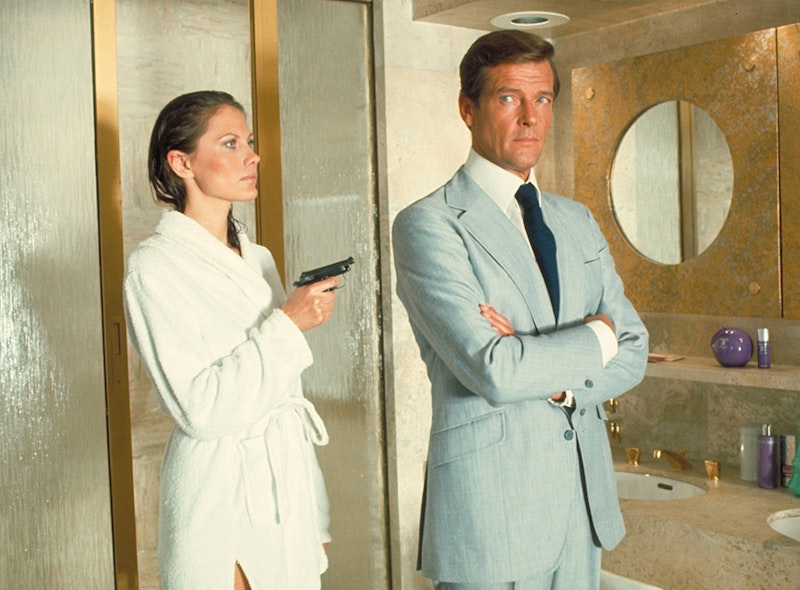The Man With the Golden Gun has no business being a bad movie. And yet it is. It’s a James Bond movie, released in 1974, in which Bond engages in a one-on-one battle with an elite assassin, his symbolic and literal opposite. That assassin has a signature weapon, a golden gun that can be assembled out of ordinary items: cufflinks, a pen, a cigarette lighter. The showdown between Bond and the assassin comes on the latter’s private island, where he’s constructed a twisted funhouse with a hall of mirrors and wax statues in which to stage a hunt of Bond in the manner of The Most Dangerous Game.
All of this is good, and the assassin’s played by Christopher Lee. Lee was in intelligence and special forces in World War II; a step-cousin and golf partner of Bond creator Ian Fleming; and, finally, was Christopher Lee, a movie star with an imposing presence who specialized in terrifying villains. Largely set in Hong Kong and Bangkok, the film incorporated martial-arts scenes, nodding to the popularity of kung-fu cinema.
How could a movie with all this going for it go wrong? It’s not even slightly faithful to the book, but that’s not the problem. A late and poorly-regarded entry in Fleming’s Bond canon, the novel has Bond tangling with Francisco Scaramanga, a Cuban assassin who schemes with gangsters and the KGB. Director Guy Hamilton and original scriptwriter Tom Mankiewicz came up with an original story, but after Hamilton and Mankiewicz clashed, the latter was let go and Richard Maibaum, who’d worked on six of the previous Bond films, was brought in to rewrite the script. Maibaum chose to minimize the idea of Bond pitted against his evil opposite number.
The film has MI6 receive a message implying Scaramanga’s chosen Bond as a target, so Bond tries to track down Scaramanga first. He works backward from the gunsmith who makes Scaramanga’s bullets, and learns Scaramanga has another target. As Bond investigates the deepening mystery, he finds Scaramanga has stolen solar power technology which he plans to sell at an extortionate price.
Bond movies typically live in set-pieces more than tightly-constructed plots, and so it is here. Still, the solar power angle is extraneous, and the movie’s too busy. It’s visually dull, as well. Peter Murton, art director for Goldfinger and Thunderball, takes over Production Design here and creates the least-memorable locations of any film to date.
More of an issue are the allegedly-humorous names the movie gives its Asian supporting characters—a gangster named Hai Fat, the gangster’s mistress named Chew Mee, and so on. It’s lazy, racist, and indicates the lack of interest the film has in its settings. That’s a particular problem because when it tries to chase the audience for kung-fu films with martial-arts action, it doesn’t know what it’s doing. The action’s poorly-shot, poorly-staged, and poorly-integrated into the film. The fights don’t do structurally what kung-fu fights do in actual kung-fu movies, and are extraneous.
The comedy’s bad. Britt Ekland plays MI6 agent Mary Goodnight; rarely has there been a more thankless task in cinema history. Goodnight is incompetent at everything she does, contrasting with Bond’s super-competence. Commentators have seen the character as the Bond franchise’s nervous reaction to feminism; whether that’s so or not, the character and the comedy bits don’t work. An extended cameo from a character in the last movie, a fat Southern sheriff stereotype (Clifton James), is an even more poorly-judged choice.
The comedy moves the film away from the interesting weirdness of earlier films toward the mainstream. It sends up the characteristic technothriller strangeness of the Bond franchise, undermining what makes the Bond movies what they are. It’s supposed to be an action film, but the best stunt of the movie—a thrilling shot in which a car jumps across a river while twisting in mid-air, one of the first stunts planned out by computer to get the angles right—is ruined by the addition of a slide-whistle sound effect, as though declaring to the audience that you shouldn’t take this sort of thing seriously.
That undermines the specific stunt, the entire chase scene, and the physical threats to Bond in general. Add the poorly-judged martial-arts scenes, and the action elements of the movie fail. The final confrontation between Bond and Scaramanga is badly-structured and badly-edited, with Scaramanga’s lair neither established as a physical place in the way of earlier Bond villain lairs, nor shown off to its best visual advantage.
There are some nice moments, like a cruel scene from Roger Moore as Bond in which he casually threatens to break a woman’s arm, hinting at what’s underneath Bond’s unflappable facade. Lee’s perfect in an underwritten role. The golden gun itself, assembled out of masculine-coded items, is a good idea that isn’t used as much as it could’ve been.
These glints of quality are too few and too scattered. There are two early-1970s movies in which a British law enforcement agent goes to an island far from the Empire’s metropolitan center, and finds Christopher Lee and Britt Ekland; this one’s as bad as The Wicker Man is good. But there’s enough here that you can see how it could’ve worked. I wish film nerds on YouTube would stop wasting time re-editing Star Wars, already a pretty good movie, and try to rework this film into it what it always should’ve been.

